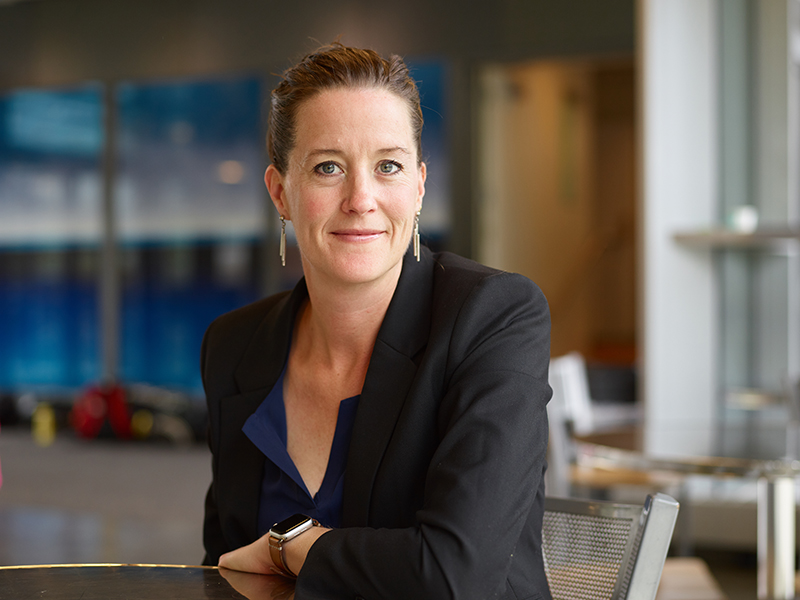A Message from Head of Middle School Vanessa O’Driscoll P’27, P’29

Dear Wheeler Middle School Families:
A friend of mine recently asked to borrow a good book to get her through a long flight. I was thrilled to share a memoir by a writer whose voice and humor reminded me of hers. Throughout her trip, my friend took photos of the passages that tickled her the most, and sent them back to me. A cyclical gift, and a delightful one. Isn’t one of life’s great joys when a recommendation is well-loved?
One of the best parts of my job as an English teacher was the opportunity to bestow gifts of writing to my students. Students sometimes swooned at how a writer could rework simple words into new patterns they’d never imagined. Usually each year someone would marvel at the idea that there are only so many words in this world, but they yield infinite combinations. Then someone would bring up the old “if you put a bunch of monkeys in a room with a typewriter could they come up with Hamlet?” (The answer, supposedly, is yes. Sort of. But not really.) And then the kids would be off on a tangent; thinking of all the preposterous “what ifs” they could, and how they’ve been tested.
As I sit here in the languid heat of summer, I play over my students’ astonishment at the vastness of language, and my mind starts to meander. A slow summer afternoon is a good time to let your thoughts unfurl. Just how many words are there in the English language? (Google tells me somewhere between 170,000 and 1 million, and the answer depends if you’re considering archaic words, pluralizations, and expansions of root words with prefixes and suffixes.) How many sensical combinations could those hundreds of thousands of words make? (Something too vast, too complex for a roomful of monkeys to land upon in our lifetime.) How could I help my students grapple with this question? How could they envision the complexities of a mathematical model and linguistic restrictions? Who on campus could help? How might this lead us to conversations about the capabilities of and dilemmas surrounding A.I.?
I can’t wait for September, when I can tell my advisees about this mind-bending thought experiment, and hear about the ones they’ve mused about in their quiet summer moments. (Once, a student asked if we ever considered that our whole universe was possibly just one cell, one of many millions of cells that made up a massive living alien, who in turn lived in another, vaster universe, with millions of other enormous aliens hosting whole universes in their cells. Another student was so overwhelmed by the notion that she dropped her jaw and simply squeaked.)
Our students wrestle with big thoughts every day, in every class at Wheeler. With their teachers, they probe complex, multidisciplinary ideas, problems, and projects. But each concept, practical or theoretical, can start with a single word, a key seed. Middle school is an age where we cycle between very big ideas and the very granular pieces that make them up and back again. Recursive learning helps meaning stick. In math, this means that a concept that was introduced in September will resurface in October and then be reworked as one building block of what happens in November. As students cycle back to old processes to unlock new layers of meaning, delight strikes. In one 8th-grade math class I watched, students flew out of their chairs, screaming and hugging each other when a concept they’d wrestled with all period finally returned a dizzyingly simple conclusion at the end of the hour.
Do you feel like you reuse the same words over and over at home? (“Please hang up your towel.” “Don’t forget to check in the lost and found for your sweatshirt.”) Of course! Adolescents need repetition at every conceptual level. It even inspired a poem at which my students always laughed knowingly. This year we will launch an evening series dedicated to discussion of the wonders of adolescent years: what to expect, how to engage, and how the school/home partnership can support our kids. Bill McCarthy, head of the Hamilton School, members of our Health Services team, and I will share best practices for getting our kids to soak up what we teach and return to their core values as they make decisions about social media, academics, and relationships. We will kick off the series at our Back to School Night on September 21 at 5:30pm, diving into some of the important ideas from Lisa Damour’s wonderful book “The Emotional Lives of Teenagers.” I may take some snapshots of some of the best passages to share.
Warmly,
Vanessa O’Driscoll P ‘27, ‘29
Head of Wheeler Middle School
P.S. Looking for the information I shared in June — summer reading, textbook requirements, and supply lists? — look no further. Here they are again:
P.P.S. Do you have some free time this summer? Ask your Middle Schooler for a book recommendation! Kids love to talk about what they’ve read, and always feel giddy when grownups have homework, too. And again, isn’t one of life’s great joys when a recommendation is well-loved?